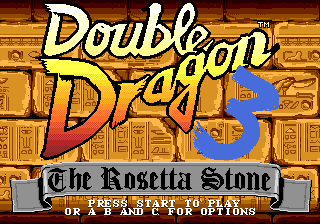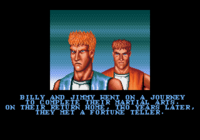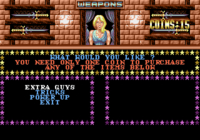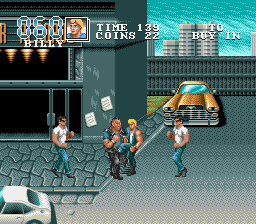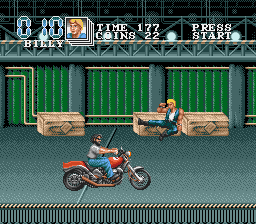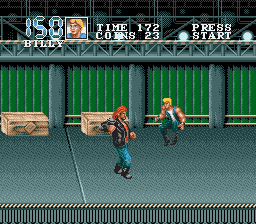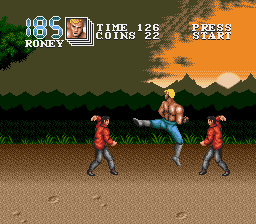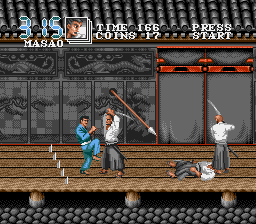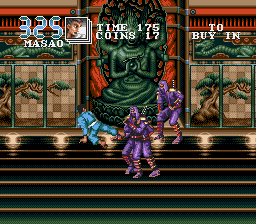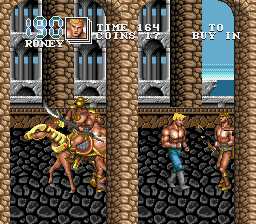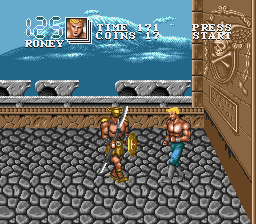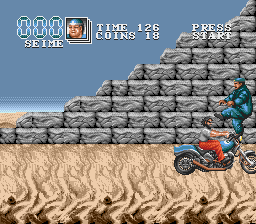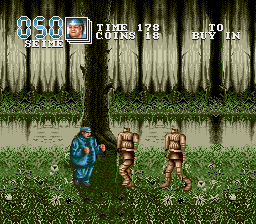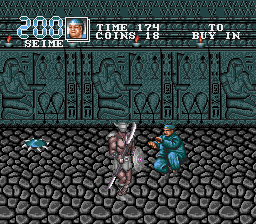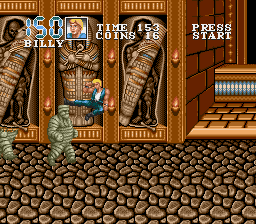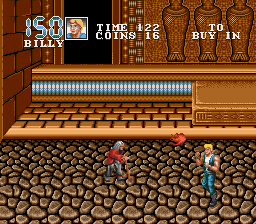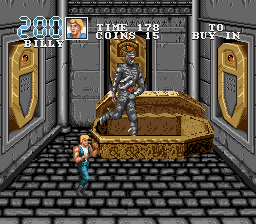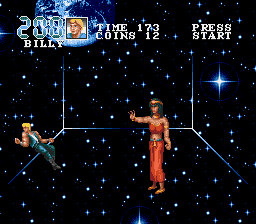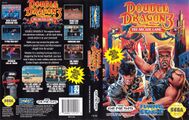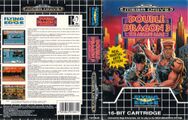Difference between revisions of "Double Dragon 3: The Rosetta Stone"
From Sega Retro
m (→Levels) |
|||
| (52 intermediate revisions by 13 users not shown) | |||
| Line 2: | Line 2: | ||
| bobscreen=DoubleDragon3 title.png | | bobscreen=DoubleDragon3 title.png | ||
| publisher=[[Flying Edge]] | | publisher=[[Flying Edge]] | ||
| − | | developer=[[ | + | | developer=[[Software Creations]] |
| − | | system=[[Sega Mega Drive]] | + | | distributor={{company|[[Tec Toy]]|region=BR}} |
| − | | | + | | licensor=[[Technos Japan]], [[Tradewest]] |
| + | | system=[[Sega Mega Drive]] | ||
| + | | sounddriver=[[Sound Images v1.2]] | ||
| + | | peripherals= | ||
| + | | players=1-2 | ||
| genre=Action | | genre=Action | ||
| − | | | + | | originaldevelopers=East Technology |
| − | | releases={{ | + | | originalsystem=Arcade boards |
| − | | md_date_us= | + | | releases={{releasesMD |
| + | | md_date_us=1993-02{{magref|sv|11|100}} | ||
| + | | md_rrp_us=49.95{{magref|gamepro|43|50}} | ||
| md_code_us=T-81166 | | md_code_us=T-81166 | ||
| md_date_eu=1993 | | md_date_eu=1993 | ||
| md_code_eu=T-81166-50 | | md_code_eu=T-81166-50 | ||
| + | | md_date_uk=1993-05{{magref|segapro|20|20}} | ||
| + | | md_code_uk=T-81166-50 | ||
| + | | md_rrp_uk=39.99{{magref|sfuk|14|16}}<!--44.99{{magref|mdag|9|39}}--> | ||
| md_date_br=199x | | md_date_br=199x | ||
| md_code_br= | | md_code_br= | ||
}} | }} | ||
| + | | otherformats={{NonSega|Arcade|Amiga|CPC|ST|C64|IBMPC|GB|Spectrum}} | ||
}} | }} | ||
| − | + | '''''{{PAGENAME}}''''' is a 1990 arcade beat-'em-up from [[Technos Japan]], part of their ''Double Dragon'' series, and was developed by East Technology. It was ported by [[Software Creations]] to the [[Sega Mega Drive]] and published in 1993 by [[Flying Edge]]. | |
| + | |||
| + | The box art refers to the game as '''''Double Dragon 3: The Arcade Game''''', distinguish it from the earlier ''Double Dragon III: The Sacred Stones'', an [[NES]] adaptation of the game produced by Technos and published in the west by [[Acclaim]] (the parent company of [[Flying Edge]]), which differed significantly from its arcade counterpart. | ||
| + | |||
| + | ==Story== | ||
| + | {{ScreenThumb|Double Dragon 3, Introduction.png|align=left|width=200|Billy and Jimmy Lee}} | ||
| + | After returning home from a two-year training mission, Billy and Jimmy Lee come across a fortune teller named Hiruko. The woman tells the Lee brothers that in order to challenge the world's strongest adversary, they must seek out the three Rosetta Stones that have been scattered around the world. | ||
| + | |||
| + | The game begins in the United States, where the Lee brothers must defeat the remnants of the Black Warriors gang from the previous games before they set off to find the stones. Afterward, the heroes must travel to China, Japan, Rome, and finally Egypt, where each of the stones are being guarded by formidable fighters unique to each country (such as the shinobi in Japan and archers in Rome). Once all three Rosetta Stones have been procured, the Lee brothers' journey reaches its final destination in Egypt, where they face all sorts of supernatural creatures as they enter Cleopatra's tomb to uncover the mystery surrounding the stones. | ||
==Gameplay== | ==Gameplay== | ||
| − | The | + | {{ScreenThumb|Double Dragon 3, Store.png|width=200|Weapon shop}} |
| + | The game is a belt-scrolling beat-'em-up that can be played by one player or by two players simultaneously. Players one and two control returning heroes Billy and Jimmy Lee respectively. The second player can join the game at any time by pressing {{Start}}. | ||
| + | |||
| + | Characters move around in the plane using the D-Pad. They run with {{left}}{{left}} or {{right}}{{right}} (though there is no special running animation) and jump with {{B}}. The game discards the directional attack buttons from ''[[Double Dragon II: The Revenge]]'', returning to the control scheme of the original ''[[Double Dragon]]'' where characters punch with {{A}} and kick with {{C}}. Characters can do a head butt by pressing {{A}} while running. They perform a flying kick with {{C}} while in midair. While an opponent is downed, characters can jump toward them and stomp them with {{B}}. Moves such as the elbow strike and the hair grab had been removed and replaced with new abilities. | ||
| + | |||
| + | The first three stages have a weapon shop at the beginning, which can be entered through a door. The weapon shop allows players to buy upgrades in exchange for coins. While the original arcade game required players to insert actual coins into the cabinet, the Mega Drive port starts players out with 15 coins (which can be increased up to 25 coins in the options). The coin count increases by 5 if a second player joins the game. Players earn coins at the end of each stage. The upgrade selections varies slightly between stages but usually includes Extra Guys, Tricks, Power Up, and Weapons. Tricks unlocks the hurricane kick, which is performed with {{up}}+{{C}}, as well as a special throw particular to the character, which is performed with {{down}}+{{C}} when near an enemy. Power Up restores the character's health and adds another 50 health points. Weapons arms the character with a nunchaku in the China stage or a tachi in the Japan stage. | ||
| + | |||
| + | The Extra Guys upgrade allows the player to control one of three new character types in addition to the Lee brothers (リー兄弟). These characters form other teams of fighting siblings as well, allowing each player to control a different brother. When the player's current fighter is defeated, the new one replaces him (essentially replacing the extra lives system from previous games). Each player can hold up to three extra fighters in reserve. These new fighters are: | ||
| + | |||
| + | *The Urquidez brothers (ユキーデ兄弟), Roney and Sunny. Mixed martial arts champions. Purchased in the America. Their special throw is the handstand ankle flip. | ||
| + | *The Chin brothers (陳兄弟), Seime and Taime. Tai chi experts. Purchased in China. Their special throw is the locking head squeeze. | ||
| + | *The Ōyama brothers (大山兄弟), Masao and Nunio. Karate masters. Purchased in Japan. Their special throw is the belly-to-back throw. | ||
| + | |||
| + | The Lee brothers' special throw is the jumping throw. They can also pick up weapons with {{C}} and use them with {{A}} (replacing punches). The other brothers cannot purchase or use weapons. | ||
| − | + | The health of the current character is shown as a number in the corner of the screen. The Lee brothers start with 250 health points, the Urquidez brothers start with 225, the Chin brothers with 300, and the Oyama brothers with 375. If a character loses all of his health, he is replaced by one of the reinforcement characters. The game ends if there are no reinforcements left, but the game can be continued at the cost of a coin. Players also lose a life if the stage timer runs out. | |
| + | |||
| + | ===Stages=== | ||
| + | {{InfoTable|imagewidths=320| | ||
| + | {{InfoRow | ||
| + | | title=America | ||
| + | | screenshot=Double Dragon 3, Stage 1-1.png | ||
| + | | screenshot2=Double Dragon 3, Stage 1-2.png | ||
| + | | screenshot3=Double Dragon 3, Stage 1-2 Boss.png | ||
| + | | tabs=yes | ||
| + | | desc= | ||
| + | }} | ||
| + | {{InfoRow | ||
| + | | title=China | ||
| + | | screenshot=Double Dragon 3, Stage 2.png | ||
| + | | screenshot2=Double Dragon 3, Stage 2 Boss.png | ||
| + | | tabs=yes | ||
| + | | desc=The Dragons go to China to get the first Rosetta stone. | ||
| + | }} | ||
| + | {{InfoRow | ||
| + | | title=Japan | ||
| + | | screenshot=Double Dragon 3, Stage 3-1.png | ||
| + | | screenshot2=Double Dragon 3, Stage 3-2.png | ||
| + | | tabs=yes | ||
| + | | desc=After finding the first stone, the heroes go to Japan to find the second one. | ||
| + | }} | ||
| + | {{InfoRow | ||
| + | | title=Rome | ||
| + | | screenshot=Double Dragon 3, Stage 4.png | ||
| + | | screenshot2=Double Dragon 3, Stage 4 Boss.png | ||
| + | | tabs=yes | ||
| + | | desc= | ||
| + | }} | ||
| + | {{InfoRow | ||
| + | | title=Egypt | ||
| + | | screenshot=Double Dragon 3, Stage 5-1.png | ||
| + | | screenshot2=Double Dragon 3, Stage 5-2.png | ||
| + | | screenshot3=Double Dragon 3, Stage 5-3.png | ||
| + | | screenshot4=Double Dragon 3, Stage 5-4.png | ||
| + | | screenshot5=Double Dragon 3, Stage 5-5.png | ||
| + | | screenshot6=Double Dragon 3, Stage 5-6.png | ||
| + | | screenshot7=Double Dragon 3, Stage 5-6 Boss.png | ||
| + | | screenshot8=Double Dragon 3, Stage 5-7.png | ||
| + | | screenshot9=Double Dragon 3, Stage 5-8.png | ||
| + | | tabs=yes | ||
| + | | desc= | ||
| + | }} | ||
| + | }} | ||
| − | == | + | ==Versions== |
| − | * The arcade version of ''Double Dragon 3'' featured item shops where players could gain additional moves, weapons and other playable characters by inserting more credits into the cabinet. This system was retained in the Mega Drive (despite the existence of a Japanese version that removed it), but since the console naturally lacks a coin shutter, the player instead starts off with a certain amount of credits (15 by default in 1-player mode, which is raised to 19 in 2-players mode), which are used as both, currency in item shops and for continues. Additional credits are gained after clearing a stage | + | * The arcade version of ''Double Dragon 3'' featured item shops where players could gain additional moves, weapons and other playable characters by inserting more credits into the cabinet. This system was retained in the Mega Drive (despite the existence of a Japanese version that removed it), but since the console naturally lacks a coin shutter, the player instead starts off with a certain amount of credits (15 by default in 1-player mode, which is raised to 19 in 2-players mode), which are used as both, currency in item shops and for continues. Additional credits are gained after clearing a stage. |
* The arcade version can be set for up to three players simultaneously, while the Mega Drive version only allows up to two. | * The arcade version can be set for up to three players simultaneously, while the Mega Drive version only allows up to two. | ||
| − | * The Mega Drive version features an options screen that allows the player to adjust the | + | * The Mega Drive version features an options screen that allows the player to adjust the number of credits the player start with, change the starting character for both players and turn the background music on or off before the game begins. The Japanese version of the arcade game had a character select feature, but it allowed each player to choose their individual character instead of choosing the same type for everyone. |
| − | * The purchasable items work differently in the Mega Drive version. | + | * The purchasable items work differently in the Mega Drive version. In the arcade version, Energy restores the player's health to 150%, while Power Up increases the player's movement speed. In the Mega Drive version, the Energy item was removed, but Power Up serves the same purpose. However, instead of restoring the player's health to 150%, it restores the player's health to 100% and adds 50 HP more. Both versions allow the player to purchase a stock of up to three extra fighters. However, the arcade version allows the player to have different character types in reserve, while the Mega Drive version only allows one character type at a time. This means that if the player is controlling a Lee brother and the first extra fighter purchased is a Chin brother, every additional extra fighter will be a Chin until the player runs out of extra fighters and returns as a Lee brother. |
| − | |||
| − | |||
* The name of the second Oyama brother was changed from Kunio to Nunio. | * The name of the second Oyama brother was changed from Kunio to Nunio. | ||
| − | * The starting HP for each character type are distributed differently. In the arcade version, the Lee and Oyama brothers started with 230 HP, the Urquidez brothers started with 270 and the Chin Brothers with 290 HP. In the Mega Drive version, the Lee brothers start with 250 HP, the Urquidez brothers start with 225, the Chin brothers with 300 and the Oyama brothers 375. The damage data for both, player and enemy attacks, are also different. | + | * The starting HP for each character type are distributed differently. In the arcade version, the Lee and Oyama brothers started with 230 HP, the Urquidez brothers started with 270 and the Chin Brothers with 290 HP. In the Mega Drive version, the Lee brothers start with 250 HP, the Urquidez brothers start with 225, the Chin brothers with 300, and the Oyama brothers with 375. The damage data for both, player and enemy attacks, are also different. |
| − | * The animation frames for consecutive attacks and running are missing in the Mega Drive version | + | * The animation frames for consecutive attacks and running are missing in the Mega Drive version. The enemies also lack their "stun" poses, leading to a much harder difficulty than the arcade version. |
| − | * In the arcade version, the hurricane kick is performed by doing a neutral jump and pressing the kick, while the jumping throw is performed by pressing the punch button while jumping over an enemy. In the Mega Drive version, | + | * In the arcade version, the hurricane kick is performed by doing a neutral jump and pressing the kick, while the jumping throw is performed by pressing the punch button while jumping over an enemy. In the Mega Drive version, these moves are performed by holding {{up}}+{{C}} and {{down}}+{{C}} respectively. |
* The two co-operative moves (the back-to-back hurricane kick and the triangle jump kick) were removed in the Mega Drive version. | * The two co-operative moves (the back-to-back hurricane kick and the triangle jump kick) were removed in the Mega Drive version. | ||
| − | * The arcade version have multiple music tracks for each mission for different areas and situations (including boss battles). In the Mega Drive version, there | + | * The arcade version have multiple music tracks for each mission for different areas and situations (including boss battles). In the Mega Drive version, there is only one track for each mission. |
| + | |||
| + | ==Magazine articles== | ||
| + | {{mainArticle|{{PAGENAME}}/Magazine articles}} | ||
| + | |||
| + | ==Promotional material== | ||
| + | {{gallery | ||
| + | |{{galleryPrintAd | ||
| + | |vgce|50|5 | ||
| + | |egm|44|41 | ||
| + | |egm|45|97 | ||
| + | |swatpro|11|63 | ||
| + | |gamepro|46|17 | ||
| + | }} | ||
| + | }} | ||
| − | == | + | ==Artwork== |
<gallery> | <gallery> | ||
| − | + | Double Dragon 3 The Rosetta Stone Box Art by Dave McMacken.jpg | |
</gallery> | </gallery> | ||
| − | ==Physical | + | ==Physical scans== |
| − | {{ratings | + | {{ratings|MD}} |
| − | | | ||
| − | |||
| − | |||
| − | |||
| − | |||
| − | |||
| − | |||
| − | |||
| − | |||
| − | |||
| − | |||
| − | |||
| − | |||
| − | |||
| − | |||
| − | |||
| − | |||
| − | }} | ||
{{Scanbox | {{Scanbox | ||
| console=Mega Drive | | console=Mega Drive | ||
| Line 67: | Line 139: | ||
| cover=DoubleDragon3TheRosettaStone MD US Box.jpg | | cover=DoubleDragon3TheRosettaStone MD US Box.jpg | ||
| cart=DoubleDragon3 MD US Cart.jpg | | cart=DoubleDragon3 MD US Cart.jpg | ||
| + | | manual=DoubleDragon3 MD US manual.pdf | ||
}}{{Scanbox | }}{{Scanbox | ||
| console=Mega Drive | | console=Mega Drive | ||
| Line 72: | Line 145: | ||
| cover=DoubleDragon3TheRosettaStone MD EU Box.jpg | | cover=DoubleDragon3TheRosettaStone MD EU Box.jpg | ||
| cart=DoubleDragon3 MD EU Cart.jpg | | cart=DoubleDragon3 MD EU Cart.jpg | ||
| + | | manual=DoubleDragon3 MD EU Manual.jpg | ||
}}{{Scanbox | }}{{Scanbox | ||
| console=Mega Drive | | console=Mega Drive | ||
| Line 79: | Line 153: | ||
}} | }} | ||
| + | ==Technical information== | ||
| + | {{mainArticle|{{PAGENAME}}/Technical information}} | ||
| + | |||
| + | ==References== | ||
| + | <references/> | ||
| + | |||
| + | {{DoubleDragon3Omni}} | ||
{{DoubleDragon}} | {{DoubleDragon}} | ||
Latest revision as of 11:55, 18 October 2024
| Double Dragon 3: The Rosetta Stone | |||||||||||||||||||||||||
|---|---|---|---|---|---|---|---|---|---|---|---|---|---|---|---|---|---|---|---|---|---|---|---|---|---|
| System(s): Sega Mega Drive | |||||||||||||||||||||||||
| Publisher: Flying Edge | |||||||||||||||||||||||||
| Developer: Software Creations | |||||||||||||||||||||||||
| Distributor: Tec Toy (BR) | |||||||||||||||||||||||||
| Licensor: Technos Japan, Tradewest | |||||||||||||||||||||||||
| Original system(s): Arcade boards | |||||||||||||||||||||||||
| Developer(s) of original games: East Technology | |||||||||||||||||||||||||
| Sound driver: Sound Images v1.2 | |||||||||||||||||||||||||
| Genre: Action | |||||||||||||||||||||||||
| Number of players: 1-2 | |||||||||||||||||||||||||
| |||||||||||||||||||||||||
|
Double Dragon 3: The Rosetta Stone is a 1990 arcade beat-'em-up from Technos Japan, part of their Double Dragon series, and was developed by East Technology. It was ported by Software Creations to the Sega Mega Drive and published in 1993 by Flying Edge.
The box art refers to the game as Double Dragon 3: The Arcade Game, distinguish it from the earlier Double Dragon III: The Sacred Stones, an NES adaptation of the game produced by Technos and published in the west by Acclaim (the parent company of Flying Edge), which differed significantly from its arcade counterpart.
Contents
Story
After returning home from a two-year training mission, Billy and Jimmy Lee come across a fortune teller named Hiruko. The woman tells the Lee brothers that in order to challenge the world's strongest adversary, they must seek out the three Rosetta Stones that have been scattered around the world.
The game begins in the United States, where the Lee brothers must defeat the remnants of the Black Warriors gang from the previous games before they set off to find the stones. Afterward, the heroes must travel to China, Japan, Rome, and finally Egypt, where each of the stones are being guarded by formidable fighters unique to each country (such as the shinobi in Japan and archers in Rome). Once all three Rosetta Stones have been procured, the Lee brothers' journey reaches its final destination in Egypt, where they face all sorts of supernatural creatures as they enter Cleopatra's tomb to uncover the mystery surrounding the stones.
Gameplay
The game is a belt-scrolling beat-'em-up that can be played by one player or by two players simultaneously. Players one and two control returning heroes Billy and Jimmy Lee respectively. The second player can join the game at any time by pressing START .
Characters move around in the plane using the D-Pad. They run with ![]()
![]() or
or ![]()
![]() (though there is no special running animation) and jump with
(though there is no special running animation) and jump with ![]() . The game discards the directional attack buttons from Double Dragon II: The Revenge, returning to the control scheme of the original Double Dragon where characters punch with
. The game discards the directional attack buttons from Double Dragon II: The Revenge, returning to the control scheme of the original Double Dragon where characters punch with ![]() and kick with
and kick with ![]() . Characters can do a head butt by pressing
. Characters can do a head butt by pressing ![]() while running. They perform a flying kick with
while running. They perform a flying kick with ![]() while in midair. While an opponent is downed, characters can jump toward them and stomp them with
while in midair. While an opponent is downed, characters can jump toward them and stomp them with ![]() . Moves such as the elbow strike and the hair grab had been removed and replaced with new abilities.
. Moves such as the elbow strike and the hair grab had been removed and replaced with new abilities.
The first three stages have a weapon shop at the beginning, which can be entered through a door. The weapon shop allows players to buy upgrades in exchange for coins. While the original arcade game required players to insert actual coins into the cabinet, the Mega Drive port starts players out with 15 coins (which can be increased up to 25 coins in the options). The coin count increases by 5 if a second player joins the game. Players earn coins at the end of each stage. The upgrade selections varies slightly between stages but usually includes Extra Guys, Tricks, Power Up, and Weapons. Tricks unlocks the hurricane kick, which is performed with ![]() +
+![]() , as well as a special throw particular to the character, which is performed with
, as well as a special throw particular to the character, which is performed with ![]() +
+![]() when near an enemy. Power Up restores the character's health and adds another 50 health points. Weapons arms the character with a nunchaku in the China stage or a tachi in the Japan stage.
when near an enemy. Power Up restores the character's health and adds another 50 health points. Weapons arms the character with a nunchaku in the China stage or a tachi in the Japan stage.
The Extra Guys upgrade allows the player to control one of three new character types in addition to the Lee brothers (リー兄弟). These characters form other teams of fighting siblings as well, allowing each player to control a different brother. When the player's current fighter is defeated, the new one replaces him (essentially replacing the extra lives system from previous games). Each player can hold up to three extra fighters in reserve. These new fighters are:
- The Urquidez brothers (ユキーデ兄弟), Roney and Sunny. Mixed martial arts champions. Purchased in the America. Their special throw is the handstand ankle flip.
- The Chin brothers (陳兄弟), Seime and Taime. Tai chi experts. Purchased in China. Their special throw is the locking head squeeze.
- The Ōyama brothers (大山兄弟), Masao and Nunio. Karate masters. Purchased in Japan. Their special throw is the belly-to-back throw.
The Lee brothers' special throw is the jumping throw. They can also pick up weapons with ![]() and use them with
and use them with ![]() (replacing punches). The other brothers cannot purchase or use weapons.
(replacing punches). The other brothers cannot purchase or use weapons.
The health of the current character is shown as a number in the corner of the screen. The Lee brothers start with 250 health points, the Urquidez brothers start with 225, the Chin brothers with 300, and the Oyama brothers with 375. If a character loses all of his health, he is replaced by one of the reinforcement characters. The game ends if there are no reinforcements left, but the game can be continued at the cost of a coin. Players also lose a life if the stage timer runs out.
Stages
| America | |
|---|---|
| China | |
| The Dragons go to China to get the first Rosetta stone. | |
| Japan | |
| After finding the first stone, the heroes go to Japan to find the second one. | |
| Rome | |
| Egypt | |
Versions
- The arcade version of Double Dragon 3 featured item shops where players could gain additional moves, weapons and other playable characters by inserting more credits into the cabinet. This system was retained in the Mega Drive (despite the existence of a Japanese version that removed it), but since the console naturally lacks a coin shutter, the player instead starts off with a certain amount of credits (15 by default in 1-player mode, which is raised to 19 in 2-players mode), which are used as both, currency in item shops and for continues. Additional credits are gained after clearing a stage.
- The arcade version can be set for up to three players simultaneously, while the Mega Drive version only allows up to two.
- The Mega Drive version features an options screen that allows the player to adjust the number of credits the player start with, change the starting character for both players and turn the background music on or off before the game begins. The Japanese version of the arcade game had a character select feature, but it allowed each player to choose their individual character instead of choosing the same type for everyone.
- The purchasable items work differently in the Mega Drive version. In the arcade version, Energy restores the player's health to 150%, while Power Up increases the player's movement speed. In the Mega Drive version, the Energy item was removed, but Power Up serves the same purpose. However, instead of restoring the player's health to 150%, it restores the player's health to 100% and adds 50 HP more. Both versions allow the player to purchase a stock of up to three extra fighters. However, the arcade version allows the player to have different character types in reserve, while the Mega Drive version only allows one character type at a time. This means that if the player is controlling a Lee brother and the first extra fighter purchased is a Chin brother, every additional extra fighter will be a Chin until the player runs out of extra fighters and returns as a Lee brother.
- The name of the second Oyama brother was changed from Kunio to Nunio.
- The starting HP for each character type are distributed differently. In the arcade version, the Lee and Oyama brothers started with 230 HP, the Urquidez brothers started with 270 and the Chin Brothers with 290 HP. In the Mega Drive version, the Lee brothers start with 250 HP, the Urquidez brothers start with 225, the Chin brothers with 300, and the Oyama brothers with 375. The damage data for both, player and enemy attacks, are also different.
- The animation frames for consecutive attacks and running are missing in the Mega Drive version. The enemies also lack their "stun" poses, leading to a much harder difficulty than the arcade version.
- In the arcade version, the hurricane kick is performed by doing a neutral jump and pressing the kick, while the jumping throw is performed by pressing the punch button while jumping over an enemy. In the Mega Drive version, these moves are performed by holding
 +
+ and
and  +
+ respectively.
respectively. - The two co-operative moves (the back-to-back hurricane kick and the triangle jump kick) were removed in the Mega Drive version.
- The arcade version have multiple music tracks for each mission for different areas and situations (including boss battles). In the Mega Drive version, there is only one track for each mission.
Magazine articles
- Main article: Double Dragon 3: The Rosetta Stone/Magazine articles.
Promotional material
also published in:
- Electronic Gaming Monthly (US) #44: "March 1993" (1993-xx-xx)[5]
- Electronic Gaming Monthly (US) #45: "April 1993" (1993-xx-xx)[6]
- S.W.A.T. Pro (US) #11: "May 1993" (1993-0x-xx)[7]
- GamePro (US) #46: "May 1993" (1993-xx-xx)[8]
Artwork
Physical scans
| Sega Retro Average | ||||||||||||||||||||||||||||||||||||||||||||||||||||||||||||||||||||||||||||||||||||||||||||||
|---|---|---|---|---|---|---|---|---|---|---|---|---|---|---|---|---|---|---|---|---|---|---|---|---|---|---|---|---|---|---|---|---|---|---|---|---|---|---|---|---|---|---|---|---|---|---|---|---|---|---|---|---|---|---|---|---|---|---|---|---|---|---|---|---|---|---|---|---|---|---|---|---|---|---|---|---|---|---|---|---|---|---|---|---|---|---|---|---|---|---|---|---|---|---|
|
| 44 | |
|---|---|
| Based on 18 reviews | |
Technical information
- Main article: Double Dragon 3: The Rosetta Stone/Technical information.
References
- ↑ Sega Visions, "February/March 1993" (US; 199x-xx-xx), page 100
- ↑ 2.0 2.1 GamePro, "February 1993" (US; 1993-xx-xx), page 50
- ↑ Sega Pro, "June 1993" (UK; 1993-05-13), page 20
- ↑ Sega Force, "February 1993" (UK; 1993-01-14), page 16
- ↑ Electronic Gaming Monthly, "March 1993" (US; 1993-xx-xx), page 41
- ↑ Electronic Gaming Monthly, "April 1993" (US; 1993-xx-xx), page 97
- ↑ S.W.A.T. Pro, "May 1993" (US; 1993-0x-xx), page 63
- ↑ GamePro, "May 1993" (US; 1993-xx-xx), page 17
- ↑ 1700 igr dlya Sega, "" (RU; 2001-xx-xx), page 94
- ↑ Aktueller Software Markt, "August 1993" (DE; 1993-07-12), page 136
- ↑ Cool Gamer, "9" (RU; 2002-10-13), page 67
- ↑ Electronic Games (1992-1995), "March 1993" (US; 1993-02-09), page 70
- ↑ Joypad, "Octobre 1993" (FR; 1993-xx-xx), page 163
- ↑ Sega Mega Drive Advanced Gaming, "May 1993" (UK; 1993-xx-xx), page 38
- ↑ Mega Force, "Septembre 1993" (FR; 1993-0x-xx), page 119
- ↑ Mega Fun, "05/93" (DE; 1993-0x-xx), page 63
- ↑ Player One, "Octobre 1993" (FR; 1993-xx-xx), page 153
- ↑ Play Time, "6/93" (DE; 1993-05-05), page 101
- ↑ Sega Power, "March 1993" (UK; 1993-02-04), page 28
- ↑ Sega Pro, "February 1993" (UK; 1993-01-14), page 42
- ↑ Sega Pro, "April 1993" (UK; 1993-03-11), page 65
- ↑ Sega Zone, "January 1993" (UK; 1992-12-xx), page 64
- ↑ Sega Force, "February 1993" (UK; 1993-01-14), page 14
- ↑ Supergame, "Maio 1993" (BR; 1993-05-xx), page 17
- ↑ Tricks 16 bit, "Tricks Sega Gold 800 igr" (RU; 1998-03-20), page 53
| Double Dragon 3: The Rosetta Stone | |
|---|---|
|
Main page | Comparisons | Maps | Hidden content | Magazine articles | Video coverage | Reception | Region coding | Technical information | Bootlegs | |
| Double Dragon games for Sega systems | |
|---|---|
| Double Dragon (1988) | |
| Double Dragon II: The Revenge (1991) | Double Dragon (1992) | Double Dragon 3: The Rosetta Stone (1992/1993) | Battletoads/Double Dragon: The Ultimate Team (1993) | Double Dragon V: The Shadow Falls (1994) | |
| Double Dragon (1993) | |
